
Spinning up new cloud infrastructure and virtual machines to meet fluctuations in demand has always been challenging. But if you’re not keeping a close eye on your cloud spend, you can quickly end up way over budget. Azure billing is no exception.
It’s important to stress the point that cloud cost management isn’t all about reducing costs, but about optimizing your spend by getting a clear picture of your unit economics. By using modern cloud cost observability tools, you can garner a clearer understanding of what you’re spending and how much each end user – be they internal teams or employees – costs your company. This is especially important for SaaS businesses, for whom cloud computing is one of the main cost centers.
In this blog post, we’ll explore the various challenges and solutions involved in monitoring and optimizing cloud costs for the Microsoft Azure platform.
This is part of an extensive series of guides about DevOps.
Challenges of Azure Cost Management
As a pay-per-use service that bills by the second, Azure offers total flexibility. However, that also means keeping control over costs can be challenging, particularly during periods of high or unexpected demand. While auto-scaling makes it easy to meet your computing demands, it also means an increased risk of cloud bill shock.
Like other cloud services, including Google Cloud Platform (GCP) and Amazon Web Services (AWS), Azure cost optimization requires a clear understanding of the relationships between usage, services, and costs. Overprovisioning, for example, is a common problem that requires establishing an optimal balance between service availability, compute requirements, and the various costs they incur.
- Cross-platform observability: Multi-cloud is now the standard approach, with 58% of businesses now using a combination of AWS, Azure, and GCP resources. However, most cloud cost observability tools only support one platform. This makes tooling more complicated and, as a consequence, it becomes harder to consistently manage costs across the board.
- Lack of app-specific visibility: While all the major cloud vendors provide native cost-observability tools, their ability to match cost allocations to specific projects, end users, or applications tends to be very limited. Usually, individual resources need to be tagged manually to gain a clear picture of your unit's economics. This is a time-consuming and complicated process that often requires DevOps expertise.
- Inaccurate budget forecasting: The more cloud resources you have, the harder it is to accurately track and forecast usage and budget, especially if these resources span multiple vendors and third parties. This makes it difficult to avoid under-provisioning or overprovisioning which, in turn, can cause service disruptions or have you paying for resources you’re not using.
FinOps (Financial Operations) goes beyond simply reducing your cloud bills to providing more accurate forecasting to inform budget allocations and service delivery optimization. There are now several powerful FinOps tools on the market that make that possible.
Key Features, Functions, and Tradeoffs to Look Out for When Managing Azure Spend
Cloud cost optimization tools serve to reduce cloud waste and optimize resources while still delivering an uninterrupted end-user experience. The most sophisticated solutions align with the principles of the FinOps model by facilitating collaboration between teams, ensuring every team has ownership of their cloud usage, and providing timely access to reports. To that end, here are some key considerations to look out for when choosing an Azure cost management tool:
- Visibility and usage context: As with other cloud vendors, the tools Azure provides don’t give you granular visibility over your unit economics. As such, while you can get a clear picture of your usage, it’s hard to tie that usage to specific end users, apps, or product features.
- Budgeting and forecasting: Operational expenses are relatively easy to control and forecast, which makes it hard to establish appropriate budgets. However, using a tool that leverages machine learning and artificial intelligence can empower accurate forecasting based on historical and real-time data.
- Azure platform integration: The need for out-of-the-box Azure integration might be obvious, but it’s worth noting simply because few FinOps platforms support all cloud platforms and services. Whether you use Azure to support some or all of your cloud infrastructure, you’ll need a tool that can read Azure Cost and Usage Reports (CURs).
- Free trial or demo version: While native cloud cost management solutions provided by the platform vendors themselves are usually free, a full-fledged FinOps solution will typically cost a monthly fee. As such, you’ll likely want the opportunity to give it a test run in your environment before committing to a monthly or yearly subscription.
- A cost comparison tool: Some cloud cost observability tools include cost comparison features that let you explore potential costs when using alternative services. This allows multi-cloud companies to fine-tune their resource allocation by choosing the most suitable vendor for a given workload.
Of course, the above list is by no means exhaustive, but by using these selection criteria as guidelines, you can make an informed decision when choosing from the options below (among others).
20 Azure Cloud Cost Management Tools to Consider in 2025
With cloud environments becoming increasingly complex and difficult to manage, the demand for more sophisticated cost-management and observability tools is soaring. Choosing the right tool will help you make sense of where your cloud budget is going and help drive a culture of continuous improvement and optimization.
Here are some of the most popular cost-management tools for Azure deployments:
#1. Finout
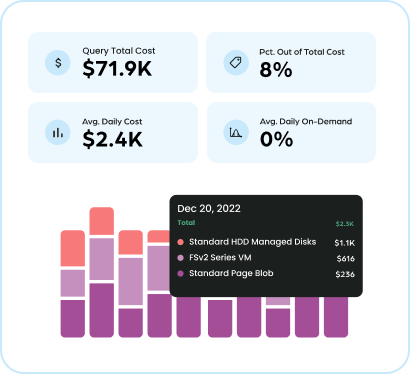
Finout is a pioneer of the burgeoning FinOps movement. Finout's holistic FinOps platform is built from the ground up to cover all core principles and capabilities of the FinOps framework, as defined by the FinOps Foundation.
Finout is a cloud cost management tool for all cloud providers and services, including full native support for the Azure platform. Finout seamlessly integrates with your Azure CURs and other APIs to provide complete visibility and control over your Azure deployments, including virtual machines, containers, storage resources, and more.
Finout goes much further than basic cloud cost-management tools to provide granular insight into the Azure unit economics that matter to you, such as the cost per app, feature, customer, project, or team. Finout also integrates with Kubernetes, Snowflake, Databricks, Datadog, and more!
Year founded: 2021, Tel Aviv, Israel
G2 score: 4.6
Best for: SaaS companies with multi-cloud environments using a combination of resources provided by some or all of the major cloud vendors.
Pricing structure: Flat monthly rate starting at $500 per month. Learn more here.
#2. Microsoft Cost Management
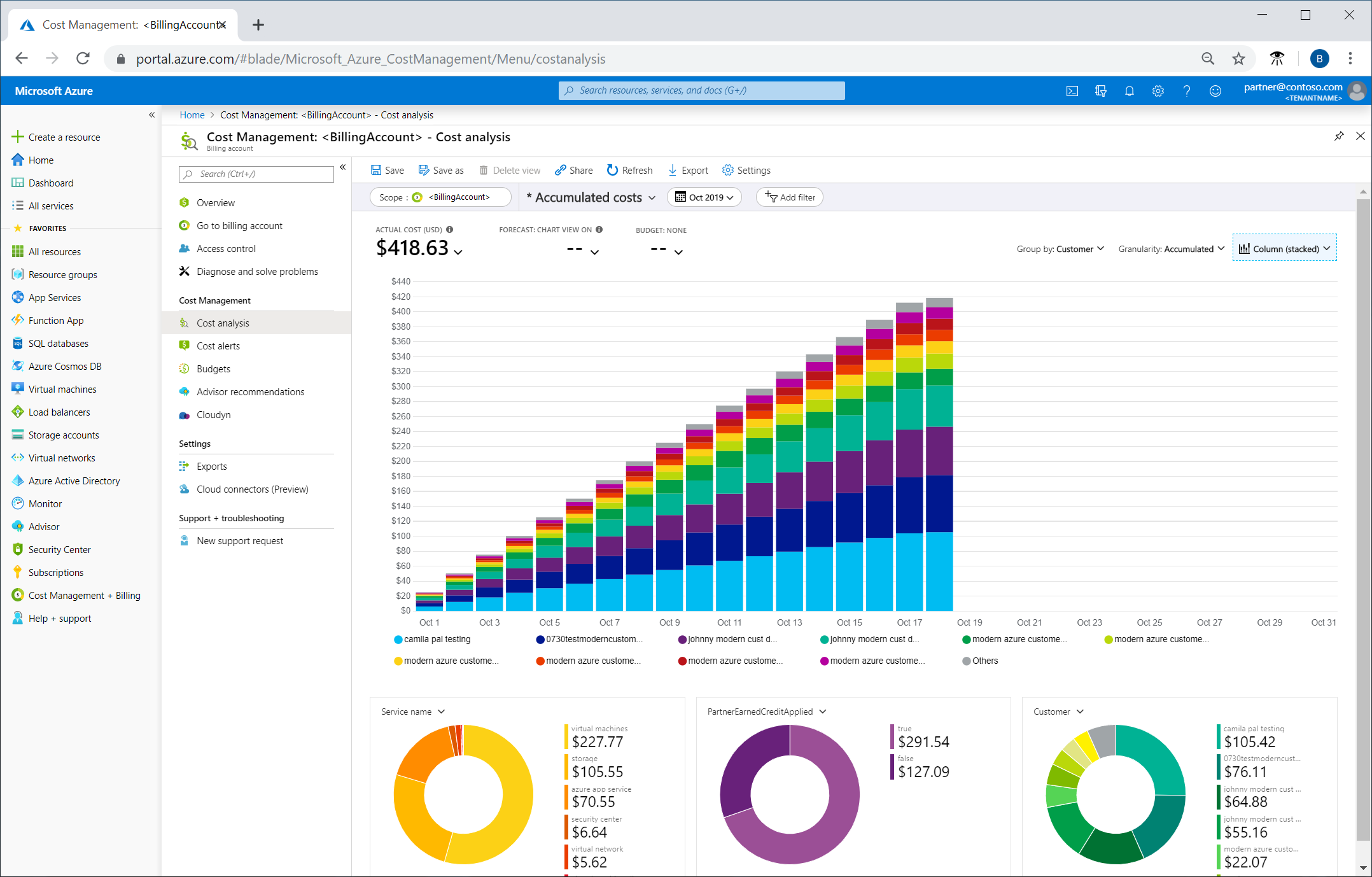
Microsoft Cost Management is a set of tools for monitoring, allocating, and optimizing cloud costs across your Azure deployments. It provides a comprehensive visual overview of usage and spending, but the catch is it only works for Azure resources (unless you pay extra. The suite includes Price calculators, Cost Analysis, Cost Alerts, Budgets, Advisor Recommendations, and Budgets.
Once you’ve enabled it, Azure Cost Management runs continuously and generates real-time reports that provide insight into anomalies, trends, and opportunities for optimization. Being a native tool that’s an integral part of the Azure environment, it integrates seamlessly with the Azure Advisor. With REST APIs, you can also integrate it with the Microsoft Power BI business intelligence platform.
Year founded: 2010, Redmond, Washington (Microsoft Azure)
G2 score: 4.2
Best for: Microsoft’s native cost management tools are ideal for businesses that exclusively use Azure Cloud, but it provides limited coverage of other platforms and services.
Pricing structure: Microsoft Cost Management is free for Azure users. However, there’s an option to connect to AWS as well, which is charged at 1% of your total AWS-managed spend.
#3. Azure Advisor
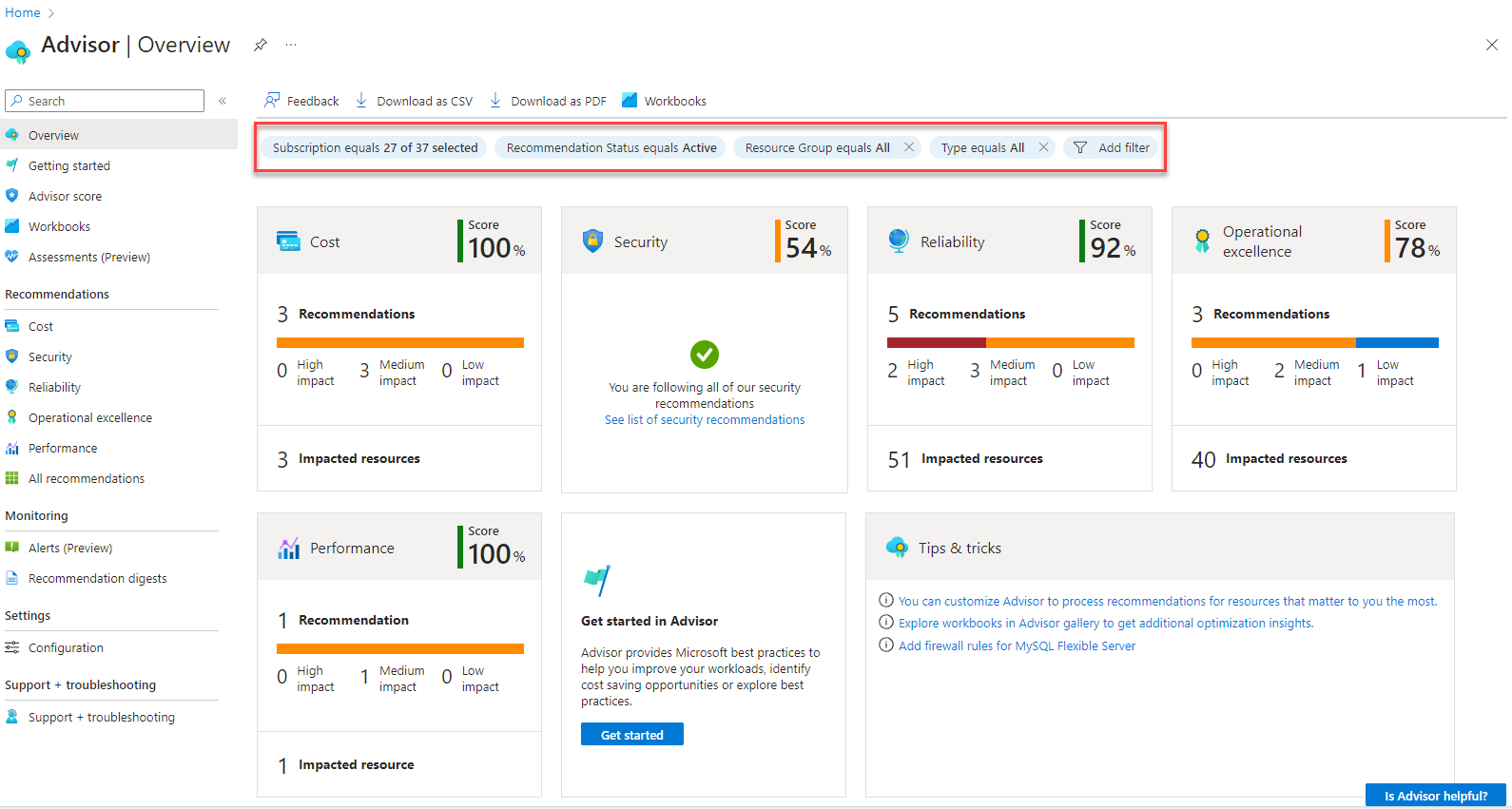
Azure Advisor is a native Azure tool that provides personalized recommendations to help you optimize your cloud resources and reduce costs. It analyzes your Azure configurations and usage patterns to identify opportunities for cost savings, performance improvements, and enhanced security.
Year founded: 2010 (Microsoft Azure)
G2 score: 4.2
Best for: Organizations looking for a simple, integrated tool to optimize Azure costs without needing third-party solutions.
Pricing structure: Azure Advisor is free for Azure users.
#4. ProsperOps
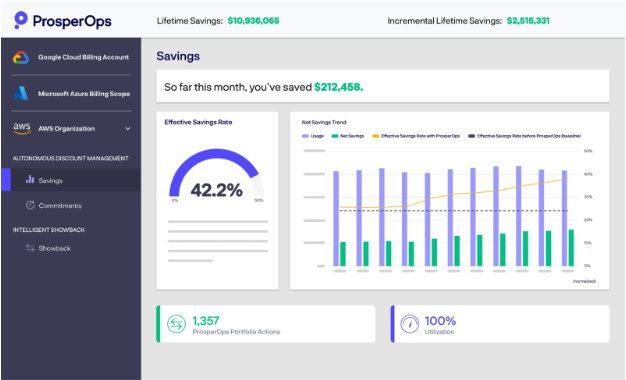
ProsperOps is a fully automated, multi-cloud cost optimization platform built for AWS, Azure, and Google Cloud. It helps FinOps and engineering teams manage cloud discount instruments without manual oversight, continuously optimizing spend using Autonomous Discount Management (ADM). By blending committed-based discounts like Reserved Instances, Savings Plans, and Committed Use Discounts, ProsperOps helps organizations achieve top-tier Effective Savings Rates (ESR) with zero effort and minimal lock-in risk.
For Azure, ProsperOps addresses several challenges that limit the effectiveness of native tools. Azure recommends Savings Plans and Reservations but doesn’t automatically execute or manage them, which leads to missed opportunities and underutilized commitments. ProsperOps closes this execution gap by dynamically creating and managing a portfolio of Azure commitments, ensuring optimal coverage while minimizing financial risk.
It also tackles the visibility and allocation issues that arise when using Shared scope commitments in Azure. With Intelligent Showback, ProsperOps automatically redistributes savings and costs to the right teams every month, saving time and eliminating disputes between finance and engineering.
Year founded: 2018
Best for: FinOps and cloud engineering teams seeking hands-free, intelligent commitment management across Azure and other hyperscalers.
Pricing structure: Zero-risk model, ProsperOps charges a percentage of the savings it delivers. Learn more here.
#5. VMWare CloudHealth
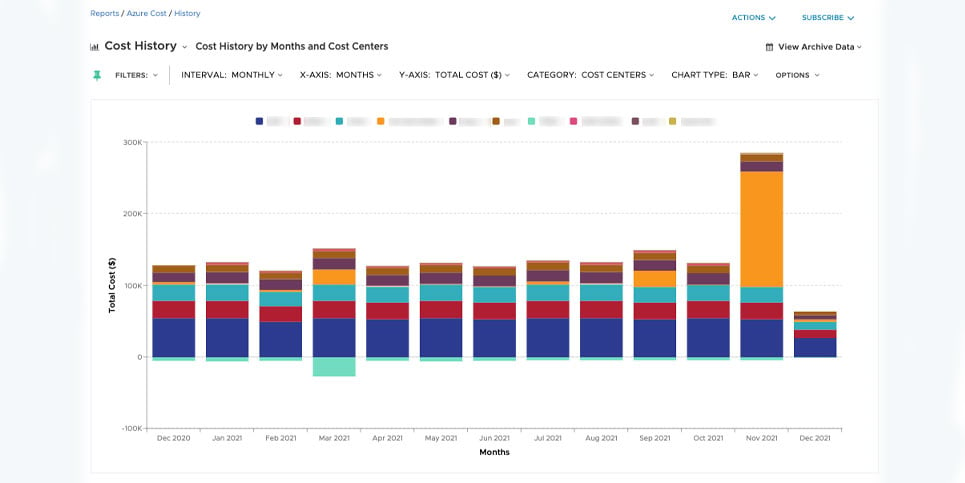
CloudHealth by VMWare is an all-in-one solution for traditional cloud cost management security and compliance. Its Azure-specific functions make it easy to create custom policies for specific workflows to give you greater control and visibility over costs. It reports these costs by project, team, or function, and you can define triggers for automated anomaly alerting.
CloudHealth provides cross-subscription visibility, cost allocation by department, project, and business function, and comprehensive data aggregation and forecasting. Since the platform also offers security monitoring, it’s intended to be used across multiple departments and plays an important role in SecOps (security operations). It also covers all the major cloud platforms, including GCP, AWS, Oracle, and, of course, VMWare itself.
Year founded: Acquired by VMWare in 2018
G2 score: 4.1
Best for: Because of its broad focus on security, compliance, and cost-management domains, CloudHealth is best suited to very large businesses with complex environments and dedicated security and finance teams.
Pricing structure: CloudHealth is a subscription-based service, but they don’t provide pricing on their website. You’ll need to request a tailored quote. However, there’s a 14-day free trial available.
#6. Apptio Cloudability
.webp?width=971&height=540&name=Cloudability-Persona-Business-Leader%20(1).webp)
Apptio Cloudability is a hybrid cloud cost management platform and a FinOps-certified service provider. It’s ideal for visualizing overall cloud costs and rightsizing resources across various cloud vendors, including AWS, GCP, and Azure. Key features include accurate forecasting, automated alerts, and its ability to identify potential cases of overspending.
Setting up Cloudability for the first time can be a lengthy and complicated process because it requires manual identification and tagging of cost allocations to specific projects, products, or teams. However, once that’s done, the tool can output data to third-party tools for advanced analysis and account cost-tracking. You can also identify and quickly shut down any unused or idle resources to further reduce your costs.
Year founded: Acquired by Apptio in 2019
G2 score: 4.2
Best for: Cloudability is best suited to large SaaS vendors and managed services providers with dedicated IT operations departments.
Pricing structure: Cloudability is a subscription-based service that offers custom pricing, with rates starting at $499 per feature per month. There’s also a free 14-day trial available.
#7. CloudCheckr
CloudCheckr provides a comprehensive platform for cloud cost management, security, and compliance. It helps businesses optimize their Azure deployments by offering features like budget tracking, cost allocation, and detailed spend analytics. CloudCheckr also integrates with various third-party tools for extended functionality.
Year founded: 2011, Rochester, New York
G2 score: 4.4
Best for: Enterprises and managed service providers seeking robust cost management combined with security and compliance features.
Pricing structure: CloudCheckr offers subscription-based pricing tailored to customer needs, with a free trial available.
#8. Spot by NetApp

Spot by NetApp focuses on optimizing cloud resources through automation. Its platform is designed to continuously monitor and manage Azure costs by dynamically adjusting resources in real-time based on demand. It includes capabilities like automated rightsizing, reserved instance management, and cost optimization recommendations.
Year founded: 2015, acquired by NetApp in 2020
G2 score: 4.7
Best for: Organizations looking for advanced automation and cost optimization, especially those with fluctuating workloads.
Pricing structure: Spot by NetApp offers custom pricing based on usage, with a free trial available.
#9. CAST AI
CAST AI offers a platform for cost optimization and governance, with a focus on Kubernetes. Its platform continuously monitors and optimizes cloud resources to reduce costs, especially for Kubernetes environments. It provides actionable insights into cloud spend, cost allocation, and optimization opportunities.
Year founded: 2020, Miami, Florida
G2 score: 4.5
Best for: Organizations running Kubernetes on Azure looking for advanced cost optimization tools.
Pricing structure: CAST AI offers pay-as-you-go pricing, with a free tier available for basic monitoring.
#10. Flexera One
Flexera One provides cloud management solutions focused on cost optimization, governance, and compliance. Its platform offers detailed cost analysis, budget tracking, and recommendations for reducing cloud spend. Flexera One also supports multi-cloud environments, making it a versatile tool for enterprises.
Year founded: 1987, Itasca, Illinois
G2 score: 4.3
Best for: Large enterprises with complex multi-cloud environments looking for comprehensive cost management and governance.
Pricing structure: Flexera One offers custom pricing based on the scope of deployment, with a free trial available.
#11. Turbonomic (IBM)

Turbonomic, acquired by IBM, uses AI-driven automation to optimize cloud resources and reduce costs. It provides visibility into cloud spending, automates resource management, and ensures applications always have the resources they need without overspending. Turbonomic integrates well with Azure and other major cloud platforms.
Year founded: 2009, acquired by IBM in 2021
G2 score: 4.5
Best for: Enterprises seeking AI-driven automation for cost and performance optimization in multi-cloud environments.
Pricing structure: Turbonomic offers custom pricing, with a free trial available.
#12. Harness Cloud Cost Management
Harness provides cloud cost management as part of its broader software delivery platform. It offers detailed cost visibility, budget tracking, and automated recommendations for optimizing Azure costs. The platform also integrates with CI/CD pipelines to ensure cost efficiency during the software delivery process.
Year founded: 2016, San Francisco, California
G2 score: 4.6
Best for: DevOps teams looking to integrate cost management directly into their software delivery pipelines.
Pricing structure: Harness offers custom pricing based on usage, with a free tier available for smaller teams.
#13. Densify
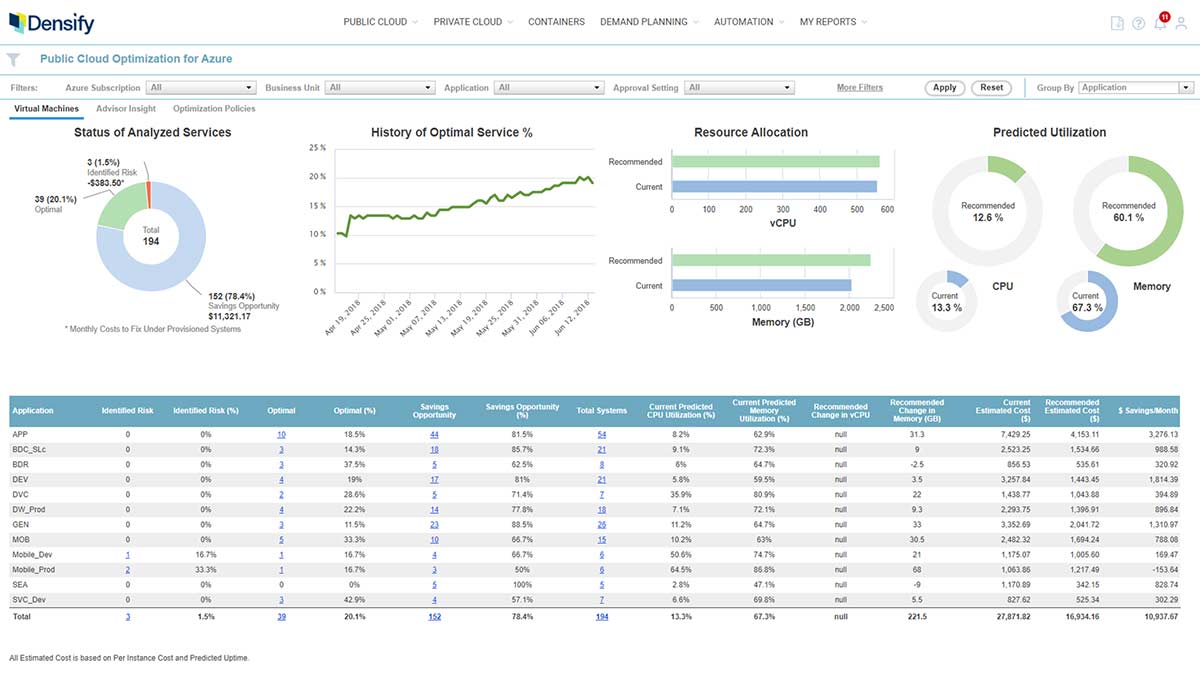
Densify provides cloud and container resource optimization, focusing on rightsizing and eliminating waste in Azure environments. It uses machine learning to analyze workloads and recommend optimal resource configurations, helping to reduce costs while maintaining performance.
Year founded: 2006, Toronto, Canada
G2 score: 4.3
Best for: Organizations with complex, dynamic workloads seeking automated resource optimization.
Pricing structure: Densify offers custom pricing based on the scope of optimization, with a free trial available.
#14. Anodot
Anodot is an AI-powered analytics platform that specializes in anomaly detection and cost optimization. It continuously monitors cloud costs and detects anomalies in real-time, helping organizations prevent overspending and optimize their Azure deployments.
Year founded: 2014, Ra’anana, Israel
G2 score: 4.5
Best for: Enterprises looking for advanced anomaly detection to prevent unexpected cloud cost spikes.
Pricing structure: Anodot offers custom pricing based on usage, with a free trial available.
#15. CloudBolt
CloudBolt provides a hybrid cloud management platform with cost optimization features. It offers detailed visibility into cloud spending, automated cost-saving recommendations, and support for multi-cloud environments, including Azure. CloudBolt is designed to help organizations manage and optimize their cloud resources efficiently.
Year founded: 2012, Rockville, Maryland
G2 score: 4.3
Best for: Enterprises with hybrid or multi-cloud environments seeking comprehensive cost management and automation.
Pricing structure: CloudBolt offers subscription-based pricing, with a free trial available.
#16. Yotascale
Yotascale is a cloud cost management platform that focuses on providing detailed visibility and optimization for Azure environments. It offers features like automated cost allocation, anomaly detection, and personalized recommendations to help organizations reduce their cloud spend. Yotascale also supports multi-cloud environments, making it versatile for various cloud strategies.
Year founded: 2015, Menlo Park, California
G2 score: 4.4
Best for: Enterprises with complex, large-scale cloud deployments looking for advanced cost optimization and anomaly detection.
Pricing structure: Yotascale offers custom pricing based on cloud usage, with a free trial available.
#17. Kubecost

Kubecost is a cost management tool specifically designed for Kubernetes environments, including those running on Azure. It provides real-time visibility into Kubernetes costs, including resource utilization and cost allocation by namespace, workload, and label. Kubecost is particularly valuable for organizations heavily leveraging Kubernetes on Azure.
Year founded: 2019, San Francisco, California
G2 score: 4.5
Best for: Organizations using Kubernetes on Azure that need granular cost visibility and optimization.
Pricing structure: Kubecost offers a free tier with basic features and paid plans based on usage.
#18. New Relic

New Relic offers full-stack observability and monitoring, including cost management features for cloud environments like Azure. It provides insights into cloud spending by linking costs to application performance and infrastructure usage, enabling teams to optimize both performance and cost.
Year founded: 2008, San Francisco, California
G2 score: 4.3
Best for: Organizations that prioritize application performance monitoring and want integrated cost management for Azure.
Pricing structure: New Relic offers a free tier and various paid plans based on data usage and feature requirements.
#19. Datadog

Datadog is a popular monitoring and security platform that includes cloud cost management features. It provides detailed insights into cloud costs and helps optimize spending by monitoring resource usage and performance across Azure and other cloud platforms. Datadog's dashboards and alerts help teams keep cloud costs under control while ensuring optimal application performance.
Year founded: 2010, New York City, New York
G2 score: 4.4
Best for: Organizations that need comprehensive monitoring and cost management across multi-cloud environments, including Azure.
Pricing structure: Datadog offers a free tier and paid plans based on the number of hosts, logs, and data usage.
#20. AppDynamics (Cisco)
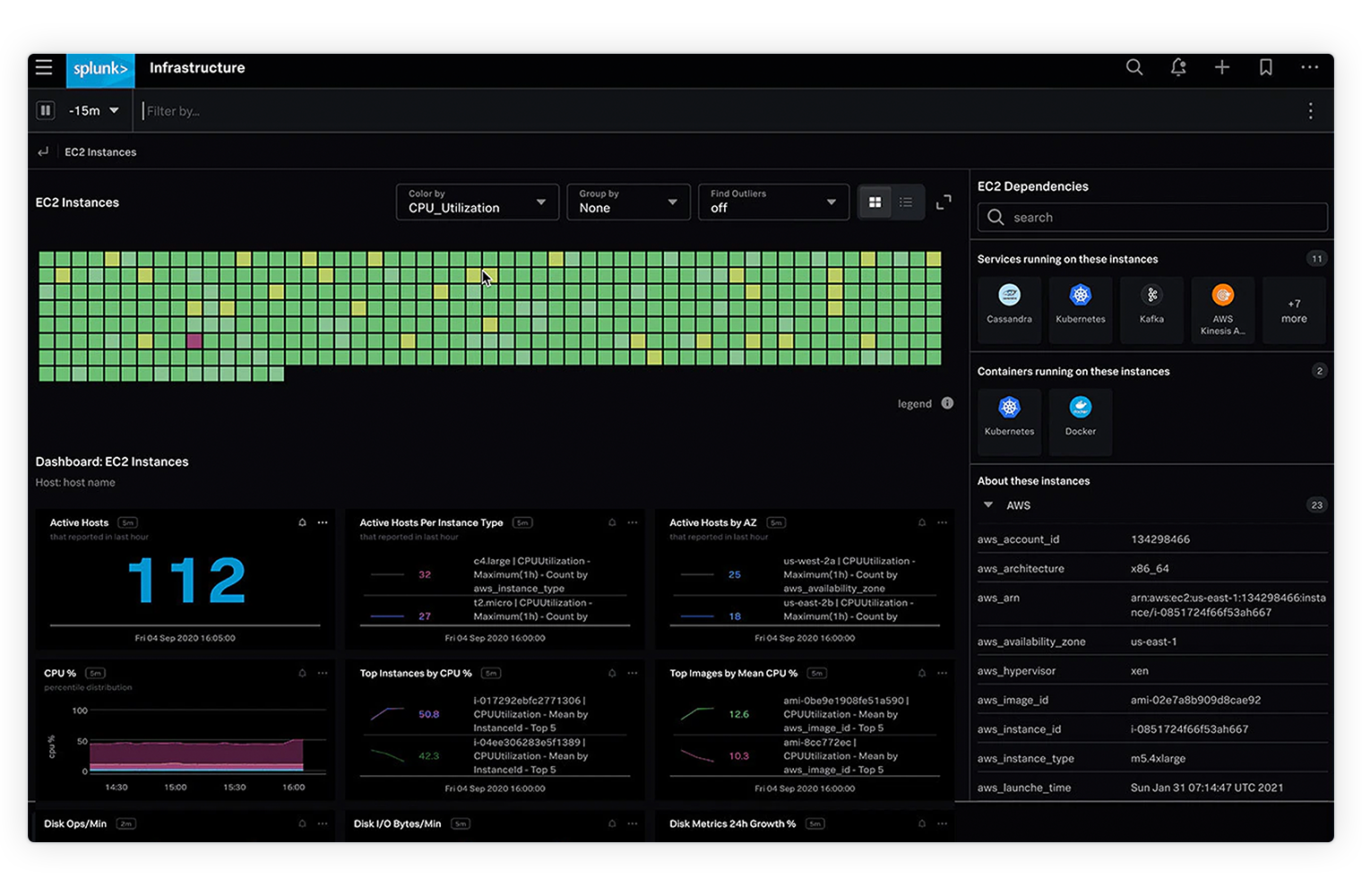
AppDynamics, a part of Cisco, is a leading application performance monitoring (APM) tool that also provides cloud cost management features. It integrates with Azure to give businesses insights into application performance and associated cloud costs, enabling better optimization of resources and expenses.
Year founded: 2008, San Francisco, California
G2 score: 4.5
Best for: Enterprises looking for integrated application performance monitoring and cost management for Azure.
Pricing structure: AppDynamics offers custom pricing based on the scope of deployment and usage, with a free trial available.
Related blogs:
Final Words
There’s more to Azure cost management than simply recording usage and applying the pricing rate. A full-fledged solution should cover all fundamental cloud cost optimization processes, such as resource planning, budgeting, cost estimation, and tracking.
The tools that we have covered in this guide are all robust options, but which solution works best for you depends on your environment, business size, and industry.
With Finout, you can put your entire cloud investment under the spotlight and enjoy a deep-dive, granular view of your environment. This will help inform strategic decision-making, boost your unit economics, and increase your cost efficiency. For today’s service-based software businesses, those benefits cannot be understated.
Finout gives businesses total cloud cost observability in minutes with a single source of truth for your cloud spend. Our latest release now includes full support for Azure cloud deployments.
See Additional Guides on Key DevOps Topics
Together with our content partners, we have authored in-depth guides on several other topics that can also be useful as you explore the world of DevOps.
Authored by Finout
- [Guide] Kubernetes Cost Optimization: 4 Cost Factors & 6 Cost Cutting Tips
- [Guide] Kubernetes Pricing: The True Cost of K8s & 5 Ways to Reduce It
- [Blog] Kubernetes health checks
- [Product] Finout | Enterprise-Grade FinOps Platform
Authored by Finout
- [Guide] AWS Cost Management Tools: Native vs. Third-Party Solutions
- [Guide] AWS Cost Anomaly Detection: Basics and Quick Tutorial
- [Webinar] How To Create a Cost-Effective AWS Environment
- [Product] Finout | Enterprise-Grade FinOps Platform
Authored by N2WS











